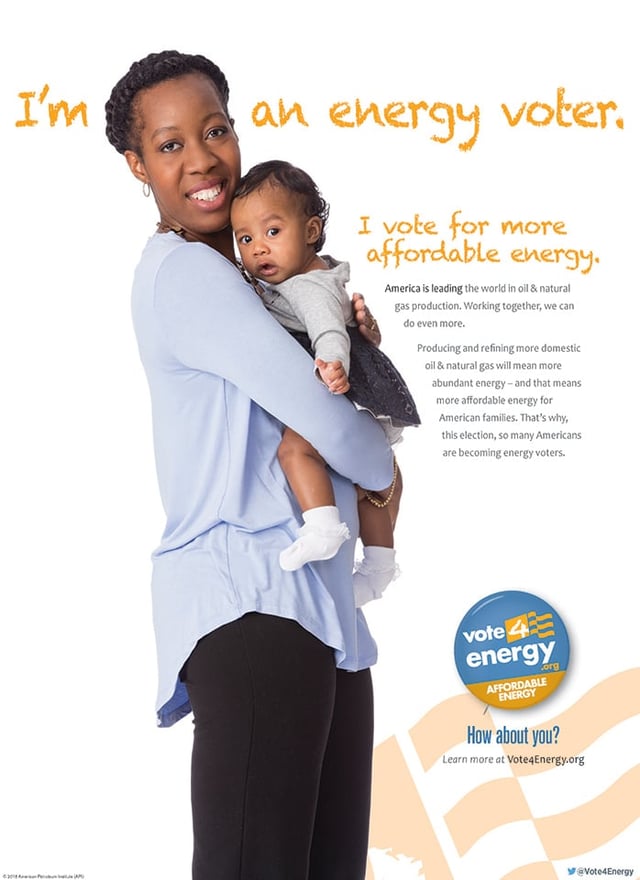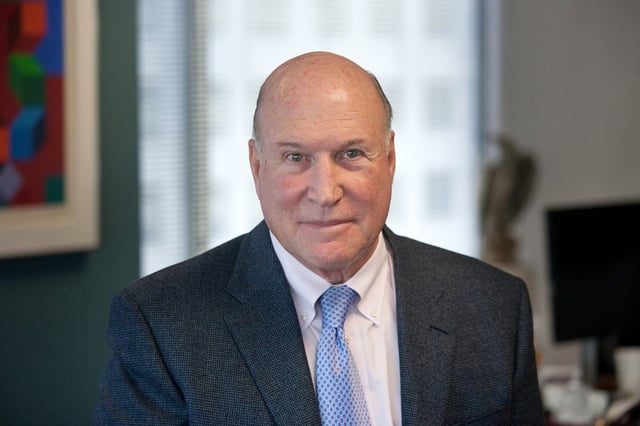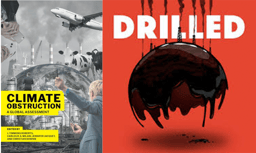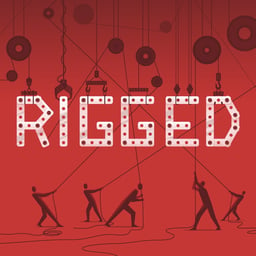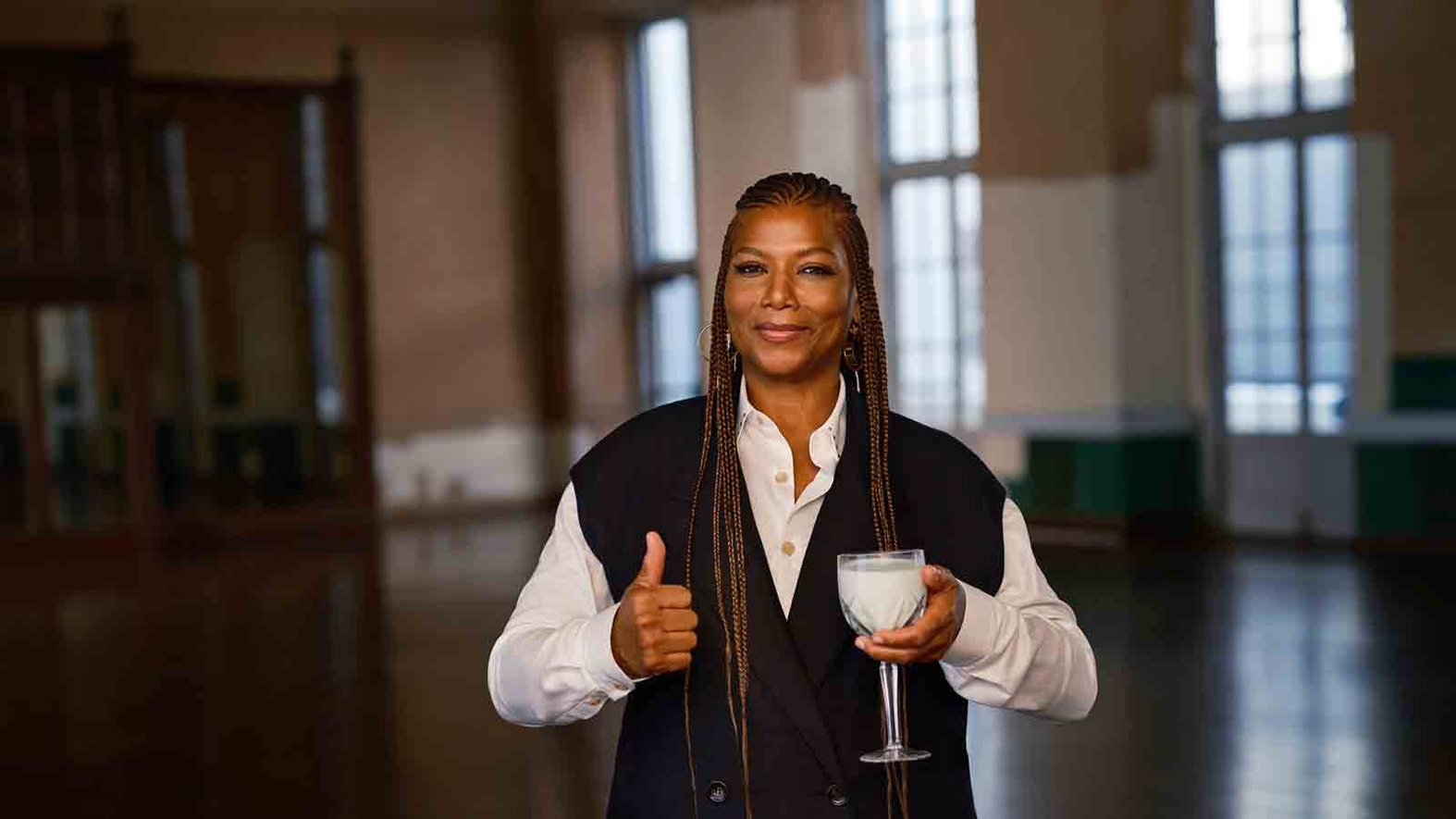
Have you ever been shamed for your choice of dairy milk over oat milk?
I haven’t, and can’t personally imagine a scenario in which anyone would care about the kind of milk in someone’s glass—but if you’ve ever gone through this harrowing anti-cow experience, Queen Latifah is here for you.
“Recently, dairy deniers all over America are subjecting [people] to milk-shaming,” the star deadpans to the camera in an advertisement released last month, tied to a campaign called OK2Milk. The fake PSA goes on to spotlight people (read: actors) who have “experienced” milk-shaming.
“Together, we can pour milk-shaming down the drain,” Latifah says at the end of the spot.
In a companion press release, the OK2Milk campaign describes “a growing phenomenon happening across social media, coffee shops, schools and in between” of people being “shamed” for “their love of an ice-cold glass of dairy milk.”
“Whether you've been ghosted on a date for your dairy decision or canceled in the comments for your cow loving content, Ok2Milk.org is a resource hub where those experiencing milk shaming can find support (and entertainment) through a like-minded community,” the release continues. “If you drink and love real milk, we want you to stand tall (and you can because of milk's nutrition profile!).”
The campaign, funded by the Milk Processor Education Program (MilkPEP), extends beyond the Queen Latifah ad. On an OK2Milk website, MilkPEP offers “resources” like profile banners and TikTok backgrounds, as well as various social media channels, including a private Facebook group for “a Milk Shame-free zone.” There’s a fake hotline, 1-888-OK2MILK, which provides callers options to further explore the idea of “milk-shaming.” (When I pressed 3, to “learn what milk is,” an automated voice asked “Why did you call an 800 number to ask what milk is? Ask anybody else,” then hung up on me.) You can even buy OK2MILK products—some of the proceeds of which, the site explains, go to an organization that works to prevent bullying.
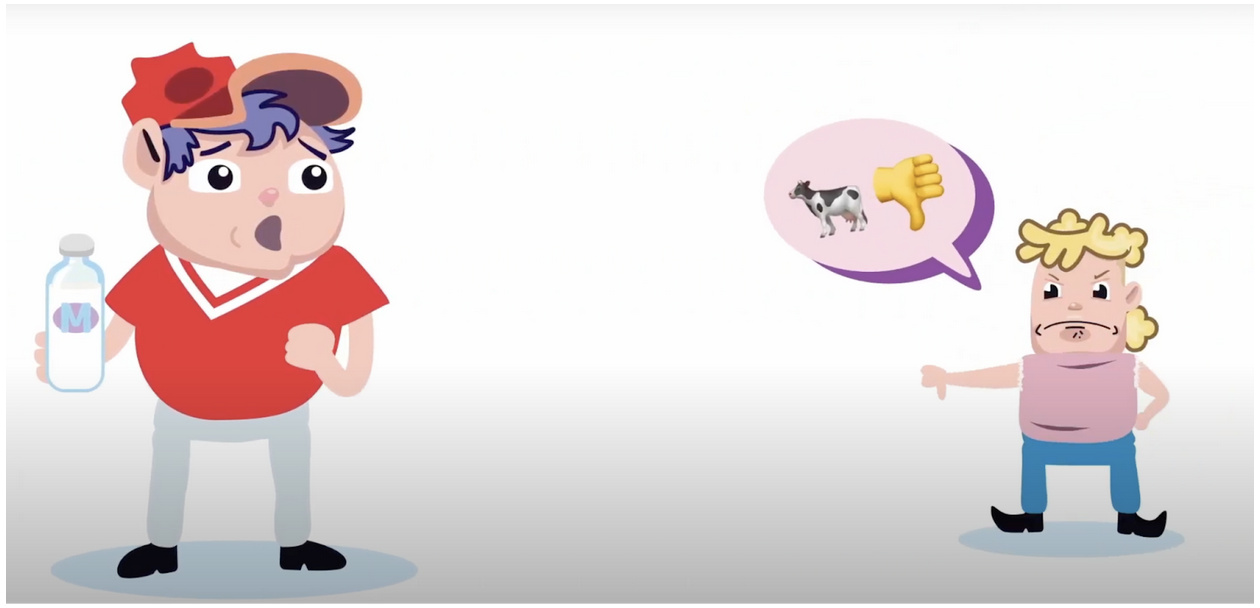
A screenshot from an OK2Milk Youtube video
Whether or not this type of humor hits your funny bone, it’s all obviously meant to be tongue-in-cheek (the OK2Milk campaign proudly told press that its Queen Latifah ad was written by two Saturday Night Live alums). Funny or not, the OK2Milk campaign disguises some real and serious panic…not so much on behalf of milk drinkers, as the industry itself.
As milk alternatives have become increasingly normalized and available over the past few years, “Big Dairy” has been kinda freaking out. OK2Milk is the latest battle in a war the powerful PR arm of the dairy industry is waging against the plant-based products they see as endangering their future.
The age of ‘Wood Milk’
MilkPEP and DMI don’t just promote increased dairy consumption: they’re also trying to turn consumers away from plant-based milks. Earlier this year, MilkPEP released an ad campaign featuring Aubrey Plaza shilling for a fake product called “Wood Milk,” where the actress sported a milk mustache dotted with wood shavings.
“Is Wood Milk real?” Plaza asks at the end of the spot. “Absolutely not. Only real milk is real.” The spot was produced by GALE Partners, a New York-based marketing agency; GALE also produced the OK2Milk and “You're Gonna Need Milk for That” campaigns. (We asked MilkPep and GALE if the OK2Milk ad had similar messaging or inspiration to the “Wood Milk” campaign, and will update this piece if they get back to us.)
It’s part of a much larger industry anxiety around the success of non-dairy milks. Market shares for plant-based milks have exploded in recent years; by the end of 2026, analysts predicted to the New York Times last year, nondairy milks could make up 30% of the milk market. The dairy industry has responded aggressively: it has spent more than $100 million since 2008 cracking down on the branding of nondairy products with dairy terms like “milk” and “cheese.”
But in February of 2023, just two months before the Wood Milk ad aired, the Food and Drug Administration issued a draft guidance allowing for beverages made of oat, soy, almond and other non-animal materials to be labeled as “milk.” Nearly all of MilkPEP’s estimated $7 million-plus ad budget has been spent in the months since the FDA issued its guidance, according to MediaRadar. (As OpenSecrets reported in August, the rest of the industry has also responded with a wave of lobbying and recruiting partners to submit comments to the FDA.)
The Wood Milk ad garnered widespread criticism around its transparent attacks on plant-based milks. It also prompted a complaint to the USDA from the Physicians Committee for Responsible Medicine, an advocacy organization that promotes a plant-based diet and advocates for animal welfare. The complaint alleged that the Wood Milk ad violates USDA rules that prohibit checkoff program funds from being used to create ads that disparage other commodities, as well as other rules against using checkoff funds to influence policy.
In an email, Mark Kennedy, Senior Vice President of Legal Affairs for the Physicians Committee for Responsible Medicine, told me that the organization hadn’t heard back from the USDA on its wood milk complaint, which it filed in May. It’s not unusual, he said, for agencies to not share information about ongoing investigations. The OK2Milk ads, Kennedy added, “do not, to my eye, unlawfully engage in product disparagement in the way that the Wood Milk campaign does. I didn’t expect to ever see a federal program that mocks social justice issues, but here it is, courtesy of the USDA’s research and promotion program for fluid milk.” (We asked MilkPEP and GALE if the OK2Milk ad was specifically designed to dissuade consumers from drinking nondairy milks, and we’ll update this piece if they respond.)
The ad wars around “real” and “fake” products only seem set to continue. The California Milk Processor Board (CMPB), which is funded by a state checkoff program, unveiled an ad in August sarcastically depicting milks made of octopus, ghosts, rainbows and hot dogs; the CMPB also rolled out a spot in October depicting a fictional startup to help people spot a “real” glass of milk and “live a more real life.” In response to assaults from the industry, nondairy brands like Oatly have launched their own spots. AdWeek reported in August that plant-based brands are looking to form their own coalition, launching next year, to tentatively push back against Big Meat and Dairy.
Ad agencies will undoubtedly benefit from this inter-industry war. Despite the backlash to Wood Milk, GALE proudly displays it on its homepage. In a branding conference hosted last month by advertising outlet AdAge, the CEOs of Gale and MilkPEP spoke together on a panel titled “From ‘Got milk?’ to ‘Wood Milk,’” detailing how MilkPEP planned to stay “culturally relevant.”
“When the FDA allowed plant-based beverages such as almond milk, soy milk and rice milk to continue to call themselves ‘milk,’ the dairy milk industry didn’t just stand by,” the event’s description reads. “Instead, the Milk Processor Education Program (MilkPEP) got cheeky.”
Who’s paying for this?
The Milk Processor Education Program, or MilkPEP, is the official business arm of the National Fluid Milk Processor Promotion Program. According to the USDA, the program “develops and finances generic advertising programs designed to maintain and expand markets and uses for fluid milk products produced in the U.S.” In order to fund these advertising programs, MilkPEP collects fees on milk processed and sold in the U.S., in what’s known as the Fluid Milk Checkoff Program.
Several commodities—everything from beef to soy to sorghum—have national checkoff programs to help industries promote their products in the U.S. The dairy industry has two: one for dairy products in general (which can include milk) and one that’s only for “fluid milk.” The 2023 dairy checkoff fund was a little over $129 million, while the fluid milk checkoff has an annual budget of around $80 million. That positively dwarfs the beef checkoff, which sits at around $49 million a year.
The modern program for fluid milk became mandatory in 1990 with the passage of the Fluid Milk Promotion Act. The funds from milk processors flowing to MilkPEP for the past 30-plus years have enabled the organization to launch nationwide campaigns to promote milk consumption—most notably the iconic “Got Milk?” campaign. Meanwhile, Dairy Management Inc (DMI), which manages the national dairy checkoff, is responsible for getting milk added to school lunch programs.
In 2014, the Milk Processor Education Program shifted gears, dropping “Got Milk?” in favor of a new slogan, "Milk Life.” Now, much of MilkPEP’s branding is focused on the strength of mik’s nutritional profile. (Protein is “really in the news and on consumer's minds," Julia Kadison, interim CEO of MilkPEP, told AdAge in 2014. "But a lot of people don't know that milk has protein, so it was very important to make that connection between milk and protein.") In recent months, MilkPEP’s “You're Gonna Need Milk for That” campaign—a separate advertising effort from OK2Milk— has used influencer Charli D’Amelio to push a song about drinking milk. MilkPEP has also sponsored various female athletes running the 2023 New York City Marathon.
With $80 million a year to play with, MilkPEP is able to put some serious cash behind its campaigns. According to data obtained by MediaRadar, an advertising intelligence database, MilkPEP spent an estimated $7.1 million on ads in the past year—$6.9 million of which went to online video ads on YouTube. That’s just what they paid for the space—never mind a creative team that apparently includes not only celebrities but also SNL writers. It’s a massive increase over their spending in previous years: between November of 2021 and 2022, MediaRadar estimates that MilkPEP spent less than $1.5 million on advertising.
Despite the cultural recognition of some of its products, the MilkPEP program, and the idea of dairy checkoffs as a whole, isn’t universally popular among dairy farmers. Dairy farmers have long demanded more transparency from the checkoff program taking their hard-earned money—especially as economic conditions have become tougher and tougher for farmers, and as milk sales have continued a decades-long drop. The USDA has lagged in recent years in providing the mandated spending reports around the dairy checkoff program to Congress, leading to bipartisan calls from lawmakers in September to release backdated reports and to increase transparency around what the program actually spends its money on.
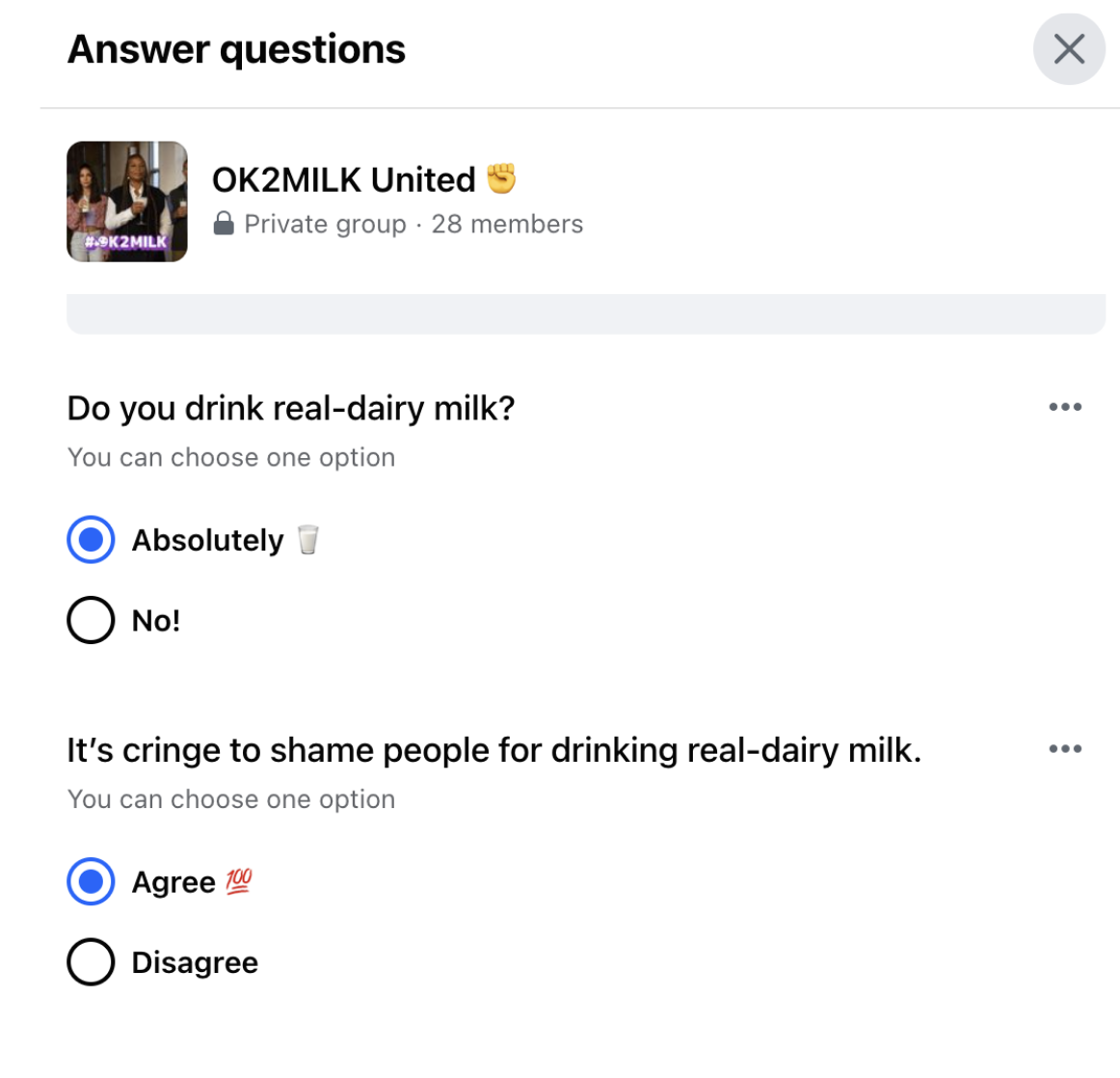
The survey users must answer before being allowed into the private OK2Milk Facebook group.
Why “milk-shaming?”
The OK2Milk campaign carefully avoids talking about any other ingredients for milk — there’s no mention of oat, almond, or soy anywhere across their various ads or social channels, and it’s never made explicit why people might be shamed for drinking cow’s milk. (The concept of hiring predominantly people of color to make an ad affirming people’s choices to drink dairy milk rings odd considering how closely milk consumption has been linked to white supremacist groups.) MilkPEP didn’t answer Drilled’s questions about what incidents inspired this particular campaign, or what specific messages it hoped consumers took away from the ads. But according to Jennifer Jacquet, a University of Miami professor who researches the role of the animal ag industry in obstructing climate action, ads like these are all part of the industry’s reaction to a key shift in climate activists’ messaging around meat and dairy in recent years.
“One thing that’s become clear in the animal-environment space is that we’d rather turn half of meals vegetarian than half of America vegetarian,” Jacquet told Drilled. “It seemed more attainable, because if there’s one truth about food and people it’s that we’re incredibly flexible about our diet. And that is a threat to the animal ag industry.”
That’s why the industry has increased its spending on PR over the past two decades, according to Jacquet. “In terms of climate-specific spending, it starts in the U.S. with the response to Beyond Beef in the 1990s, then Europe had its Less Meat Less Heat campaign in the lead-up to the COP in Copenhagen in 2009.”
Ideas like “meatless Mondays,” really sent the industry into a tailspin, Jacquet said. In the U.S. a lot of the response has centered around professor Dr. Frank Mitloehner at the University of California at Davis. “The industry unrolled this backlash, led by Frank Mitloener, putting out press releases with titles like ‘Don’t Blame Cows for Climate Change,’” Jaquet said. “And the message was basically we need to do something about climate change, but it does not mean people should eat less meat.”
In a forthcoming study, Jacquet found that dairy and meat companies fight the hardest against the idea that consumers should choose lower-emission alternatives. This is in direct contrast to the fossil fuel industry, which has really leaned into the idea of consumer choice as a climate solution, largely to avoid any sort of systemic regulation of its product.
“The messaging they get riled up about is “eat less meat and dairy,’” Jacquet said. “They don’t really take seriously a call to create a vegan, no-meat world. I mean, they use it as hyperbole, to react against, but there’s no actual campaigns against vegans.”
Whether farmers and ranchers like the checkoff programs or not, then, they’re probably not going anywhere; if consumer choice is the key battle, advertising and PR are critical to the industry’s survival. “They have to either keep everyone consuming at the same levels, or push a significant segment of the market to overconsume,” Jacquet said. That’s part of why we’ve seen such an emphasis on diet fads and food trends centered around heavy amounts of meat and dairy in recent years, according to Jacquet. “The meat and dairy industries recognized a long time ago the value of food influencers, nutritionists, and wellness influencers,” she said.
Amy Westervelt contributed reporting to this piece.

